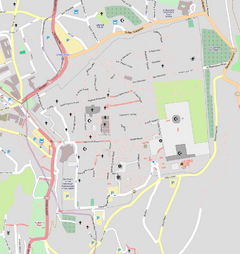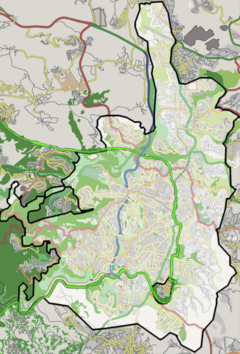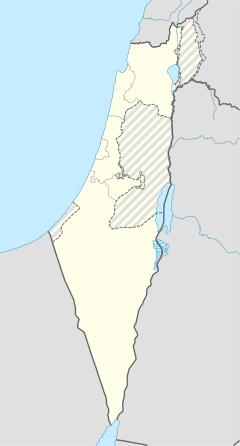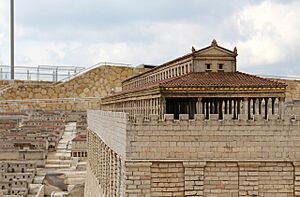Second Temple facts for kids
Quick facts for kids Second TempleHerod's Temple |
|
|---|---|
|
בֵּית־הַמִּקְדָּשׁ הַשֵּׁנִי
|
|
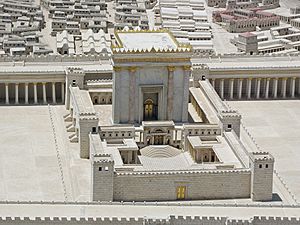
Model of Herod's Temple (inspired by the writings of Josephus) displayed within the Holyland Model of Jerusalem at the Israel Museum
|
|
| Religion | |
| Affiliation | Judaism |
| Region | Land of Israel |
| Deity | Yahweh |
| Leadership | High Priest of Israel |
| Location | |
| Location | Temple Mount |
| Municipality | Jerusalem |
| State | Yehud Medinata (first) Judaea (last) |
| Country | Achaemenid Empire (first) Roman Empire (last) |
| Architecture | |
| Founder | Zerubbabel; refurbished by Herod the Great |
| Completed | c. 516 BCE (original) c. 18 CE (Herodian) |
| Destroyed | 70 CE (Roman siege) |
| Specifications | |
| Height (max) | c. 46 metres (151 ft) |
| Materials | Jerusalem limestone |
| Excavation dates | 1930, 1967, 1968, 1970–1978, 1996–1999, 2007 |
| Archaeologists | Charles Warren, Benjamin Mazar, Ronny Reich, Eli Shukron, Yaakov Billig |
| Present-day site | Dome of the Rock |
| Public access | Limited; see Temple Mount entry restrictions |
The Second Temple was a very important Jewish holy building in Jerusalem. It was built to replace Solomon's Temple, which was destroyed in 587 BCE. Construction of the Second Temple finished around 516 BCE. Later, Herod the Great made it much bigger and more beautiful around 18 BCE, which is why it's also known as Herod's Temple.
This Temple was central to Jewish life for many centuries. It was the main place for worship and gatherings. Jewish people would travel there for important festivals like Passover, Shavuot, and Sukkot. The time when this Temple stood is called the Second Temple period.
In 539 BCE, the Persian Empire took over Babylon. This allowed Jewish people who had been forced to leave their homeland to return to Jerusalem. This return is known as the return to Zion. The Persian king Cyrus the Great encouraged them to go back and rebuild their Temple. The original Second Temple was a simpler building, built under the leadership of Zerubbabel.
Herod the Great's changes in the 1st century BCE made the Temple a huge and impressive structure. The area around it, called the Temple Mount, became twice as big. It was the largest religious site in the ancient world.
Sadly, in 70 CE, during a war with the Romans, the Second Temple was destroyed. This was a huge moment in Jewish history. After its destruction, Rabbinic Judaism developed, which is still the main form of Jewish religious practice today.
Contents
The Second Temple
Building the Temple
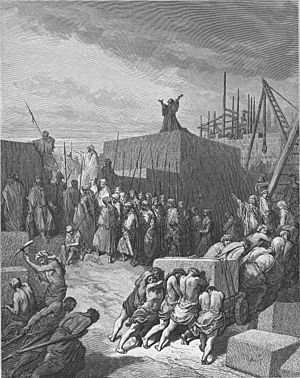
After the Persian Empire took control, Jewish people could finally return to Jerusalem. They had been forced to leave their home by the Babylonians many years before. Even though the first Temple was destroyed, some religious rituals had continued there.
According to ancient texts, when the Jewish exiles came back, they immediately started to rebuild their holy house. They were very excited and dedicated to this project. First, they rebuilt the altar for sacrifices exactly where it used to be. Then, they cleared away the ruins of the old Temple.
In 535 BCE, the foundations of the Second Temple were laid. This was a very emotional moment for everyone. People were both excited and a little sad, remembering the old Temple.
The Samaritans, another group of people living nearby, offered to help. But the Jewish leaders, like Zerubbabel, politely refused. They felt it was their duty to build the Temple themselves. This led to some problems, as the Samaritans tried to stop the work. They sent messages to the Persian king, and the building was paused for a while.
After some time, a new Persian king, Darius the Great, came to power. In his second year (522 BCE), the work on the Temple started again. Prophets like Haggai and Zechariah encouraged the people to finish the job. The Temple was finally completed in the spring of 516 BCE. This was more than 20 years after the Jewish people returned from exile. Everyone celebrated, even though they were still under Persian rule.
Some important items from the first Temple were lost and not found for the Second Temple. These included the Ark of the Covenant, which held the Tablets of Stone. However, many golden vessels that the Babylonians had taken were returned by Cyrus the Great.
The Bible doesn't give many details about the Temple's design. It says it was about 30 meters (100 feet) wide and 30 meters (100 feet) high. It was built with stone and wood. Inside the Second Temple, the holiest area, called the Holy of Holies, was separated by curtains, not a solid wall. It still had important items like the Menorah (a golden lampstand), the Table of Showbread, and the golden altar for incense.
Rededication by the Maccabees
After Alexander the Great conquered the region, Judea became part of the Egyptian kingdom ruled by the Ptolemies. Later, in 200 BCE, the Seleucid king Antiochus III the Great from Syria took control.
In 167 BCE, King Antiochus IV Epiphanes did something that angered the Jewish people greatly. He ordered an altar to the Greek god Zeus to be built inside the Temple. He also tried to force Jews to stop following their religious laws. This included making them sacrifice pigs on the altar, which was forbidden. Many Jews refused and were punished.
These actions led to the Maccabean Revolt. This was a fight for freedom led by Judas Maccabeus and his family, the Hasmoneans. After several years of fighting, the Maccabees won. In 164 BCE, they took back the Temple Mount, removed the pagan altar, and cleaned and rededicated the Second Temple.
This important event is why Jewish people celebrate Hanukkah every year. It starts on the 25th day of the Jewish month of Kislev. The holiday remembers the cleansing and rededication of the Temple.
Herod's Big Makeover

Around 20 BCE, Herod the Great, who was king of Judea, started a huge project to rebuild and improve the Second Temple. The original Temple built by Zerubbabel was replaced with a truly magnificent building. Herod's Temple was one of the biggest construction projects of its time.
Herod wanted to be remembered for his building achievements. His projects were very expensive and paid for by heavy taxes. But his greatest work was the Temple in Jerusalem.
According to the historian Josephus, the main Temple building took about a year and a half to build. The outer walls and walkways took another eight years. Herod was very careful not to upset religious feelings. He hired 10,000 workers and trained 1,000 priests especially for the construction. Daily religious offerings continued without stopping.
Even though the main parts were finished during Herod's rule, construction on the Temple complex continued for many decades. It might have gone on until the 60s CE.
Under Roman Rule
In the early 40s CE, a big problem happened. The Roman Emperor Caligula ordered a statue of himself to be placed in the Temple. This was a huge insult to Jewish beliefs, as they did not worship idols. Jewish people in Judea and Galilee protested strongly. They even sat down to block the Roman army from bringing the statue. Jewish leaders also tried to convince Caligula not to do it. The problem was solved when Caligula was killed in 41 CE.
Herod's Temple Design
The Second Temple in Jerusalem was incredibly large. It was much bigger than most other temples in the Roman Empire.
Historians like Flavius Josephus and ancient Jewish writings describe what the Temple might have looked like. These descriptions have helped people create models of the Temple.
Temple Structure
The Temple itself stood where the Dome of the Rock is today. Its gates led to areas near where the Al-Aqsa Mosque now stands.
A golden vine decorated the Temple gates. It was so famous that even the Roman historian Tacitus mentioned it.
Temple Mount Expansion
Herod's rebuilding project started with making the Temple Mount much larger. The Temple Mount area was originally about 7 hectares (17 acres). Herod expanded it to 14.4 hectares (36 acres), doubling its size. This made it a huge platform.
To do this, a trench was dug around the mountain. Then, enormous stone blocks were laid. Some of these stones weighed over 100 tons! The largest one found weighs around 567–628 tons.
Court of the Gentiles
The Court of the Gentiles was a large open area. It was like a marketplace where people could buy souvenirs, animals for sacrifice, and food. Money changers also worked there, exchanging Roman money for special Tyrian coins. This is mentioned in the New Testament story of Jesus and the Money Changers. During festivals like Passover, Jerusalem would be full of pilgrims, maybe 300,000 to 400,000 people.
Above the Huldah Gates, on top of the Temple walls, was the Royal Stoa. This was a grand building with many columns. Josephus called it "more worthy of mention than any other [structure] under the sun." It had 162 columns in four rows.
Inner Courts
According to Josephus, there were ten entrances to the inner courts of the Temple. Four were on the south, four on the north, one on the east, and one, called the Nicanor Gate, led from the Court of Women to the Court of the Israelites. Herod the Great also placed a golden eagle above the great gate of the Temple.
Roofs
Archaeological findings suggest that the roofs of the Second Temple did not have domes. This matches Josephus's descriptions of the Temple.
Destruction of the Temple

In 66 CE, the Jewish people in Judea started a rebellion against the Roman Empire. Four years later, in 70 CE, Roman armies led by Titus attacked and destroyed much of Jerusalem and Herod's Temple.
Some historical accounts say that a Roman soldier accidentally set the Temple on fire, even though Titus wanted to save it. However, other sources suggest that Titus himself ordered its destruction. Today, many historians believe Titus did authorize the destruction, but the debate continues.
Not only the Temple but also much of the Lower City of Jerusalem was destroyed. However, Titus did leave some towers standing as a reminder of the city's strength.
The Arch of Titus in Rome was built to celebrate Titus's victory. It shows Roman soldiers carrying treasures from the Temple, including the temple menorah. Some historians believe that the Colosseum in Rome was built using money and treasures taken from the Second Temple.
After the Temple's destruction, the Jewish religious groups that were based there, like the priests and the Sadducees, became less important.
Even though Jews continued to live in the ruined city, Emperor Hadrian later built a new Roman city called Aelia Capitolina on the site. After another Jewish revolt in 135 CE, many Jewish communities were harmed. Jews were then banned from entering Jerusalem. A Roman temple was built on the former site of Herod's Temple for Roman religious practices.
Legacy

Jewish tradition includes a belief that the Second Temple will one day be replaced by a future Third Temple in Jerusalem.
See also
 In Spanish: Segundo Templo para niños
In Spanish: Segundo Templo para niños
- Archaeological remnants of the Jerusalem Temple
- Herodian architecture
- Jerusalem stone
- List of artifacts significant to the Bible
- List of megalithic sites
- Replicas of the Jewish Temple
- Temple of Peace, Rome
- Temple in Jerusalem
- Timeline of Jewish history


